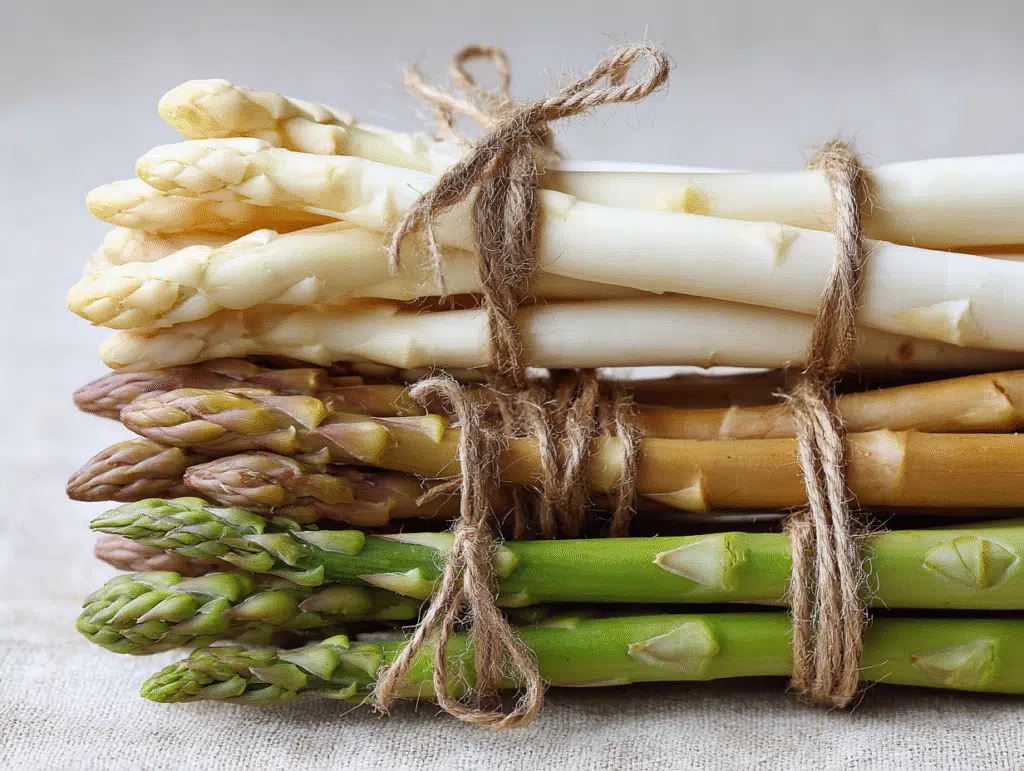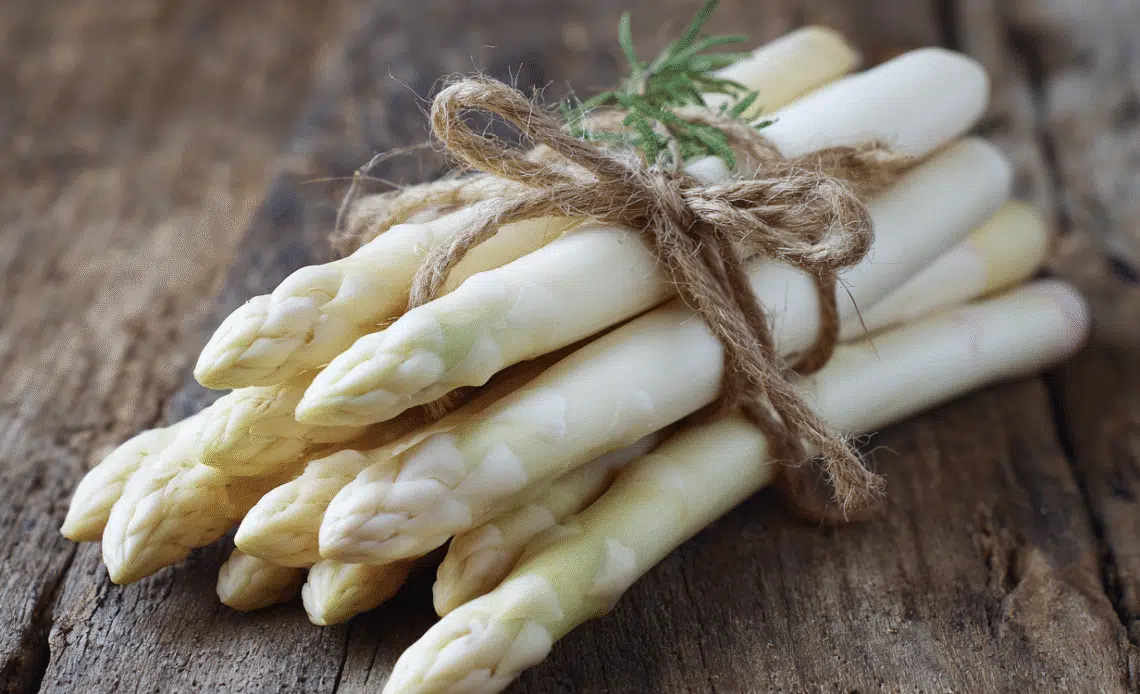Introduction
What is white asparagus? If you’ve ever browsed a European farmers’ market in spring or dined at a fine restaurant in Germany, France, or the Netherlands, you’ve likely come across this elegant vegetable. Unlike its green counterpart, white asparagus is cultivated underground, away from sunlight, which prevents photosynthesis and gives it its signature pale ivory color. Often referred to as the “royal vegetable” or “white gold,” it’s prized for its delicate flavor, tender texture, and short seasonal availability. In this guide, we’ll explore everything you need to know about white asparagus—its origins, taste, nutritional benefits, and how to cook with it.
What Is White Asparagus?
White asparagus is a variety of asparagus grown using a special technique called blanching. Farmers cover the spears with soil or dark plastic as they grow, shielding them from sunlight. This prevents chlorophyll production, which normally turns asparagus green. The result is a milder, slightly sweeter vegetable with a nutty, delicate flavor.
- Color: Pale white to ivory
- Texture: More tender and less fibrous than green asparagus
- Flavor: Subtle, earthy, with a hint of bitterness
- Season: Typically from April to June in Europe
White Asparagus vs. Green Asparagus: What’s the Difference?
Both types come from the same plant species (Asparagus officinalis), but cultivation methods set them apart.
Key Differences:
- Color: Green asparagus grows in sunlight; white asparagus is shielded from light.
- Taste: Green is grassy and robust, while white is milder and slightly bitter.
- Texture: White asparagus is thicker and needs peeling before cooking.
- Availability: Green is available year-round, but white has a short seasonal window.
- Price: White asparagus is often more expensive due to its labor-intensive growing process.
Nutritional Benefits of White Asparagus
Even though it’s less common than green asparagus, white asparagus still packs impressive nutrients.
- Low in Calories: Perfect for weight management (about 20 calories per 100g).
- Rich in Fiber: Supports digestion and gut health.
- Vitamins: Contains vitamins A, C, E, and K.
- Folate: Essential for cell growth and particularly beneficial for pregnant women.
- Minerals: Provides potassium, calcium, and iron.
- Antioxidants: Helps fight inflammation and oxidative stress.
💡 Tip: White asparagus is slightly lower in antioxidants than green asparagus due to the absence of chlorophyll, but it remains a healthy, nutrient-dense food.
How to Prepare and Cook White Asparagus
Because white asparagus has a tougher outer layer, it requires special preparation before cooking.
Step 1: Trim
- Cut about 1–2 inches off the woody ends.
Step 2: Peel
- Use a vegetable peeler to remove the tough skin starting just below the tips.
Step 3: Cook
There are several ways to enjoy white asparagus:
- Boiling/Steaming: Classic European method—cook in salted water with a pinch of sugar and lemon juice.
- Roasting: Enhances its nutty sweetness—drizzle with olive oil and roast at 400°F for 20 minutes.
- Grilling: Lightly charred for a smoky twist.
- Soup: Puree with cream or broth for a silky, comforting dish.
Delicious Ways to Serve White Asparagus: What Is White Asparagus
White asparagus pairs beautifully with simple seasonings and sauces.
- Hollandaise Sauce – A traditional German pairing.
- Melted Butter & Herbs – Classic French preparation.
- Prosciutto & Parmesan – Adds saltiness and depth.
- Eggs (Hard-Boiled or Poached) – A spring favorite.
- Soups & Salads – Light, refreshing, and versatile.
Cultural Importance of White Asparagus
In many European countries, white asparagus is celebrated as a delicacy.
- Germany: Known as Spargelzeit (“asparagus season”), with festivals and dedicated menus.
- France: Featured in Michelin-starred restaurants, often served with rich sauces.
- Netherlands & Belgium: Popular spring produce celebrated in traditional dishes.
- Spain: Particularly prized in Navarre, often canned and exported.

Step-by-Step Guide: Buying, Storing & Cooking White Asparagus
Buying Tips
- Look for firm, smooth spears with tightly closed tips.
- Avoid dry, woody, or limp stalks.
Storing Tips
- Wrap in a damp towel and refrigerate for up to 3 days.
- For longer storage, blanch and freeze.
Cooking Tips
- Peel before cooking to avoid stringiness.
- Add a pinch of sugar to the boiling water to balance mild bitterness.
- Serve immediately—white asparagus loses flavor quickly after cooking.
FAQs About White Asparagus: What Is White Asparagus?
1. Why is white asparagus so expensive?
White asparagus requires more labor to grow, as farmers must cover the stalks daily to prevent sunlight exposure, making it pricier than green asparagus.
2. Do you have to peel white asparagus?
Yes, unlike green asparagus, white asparagus has a fibrous skin that must be peeled before cooking.
3. What does white asparagus taste like compared to green asparagus?
It’s milder, more delicate, slightly bitter, and nuttier than green asparagus.
4. Is white asparagus healthy?
Absolutely. It’s low in calories, high in fiber, and rich in vitamins, minerals, and antioxidants.
5. Can you grill white asparagus?
Yes! Grilling brings out a smoky sweetness. Just peel first, drizzle with olive oil, and cook over medium heat.
6. Why is white asparagus popular in Europe but not in the U.S.?
In Europe, especially Germany and France, it’s considered a delicacy with cultural traditions. In the U.S., green asparagus is more common and widely available.
Conclusion
White asparagus may not be as common as its green cousin, but it’s worth trying at least once in your kitchen. From its delicate, nutty flavor to its cultural significance in Europe, it’s a seasonal delicacy that brings both nutrition and sophistication to the table. Whether you enjoy it with hollandaise sauce, roasted with herbs, or blended into a creamy soup, white asparagus is a vegetable that deserves a spot on your spring menu.






